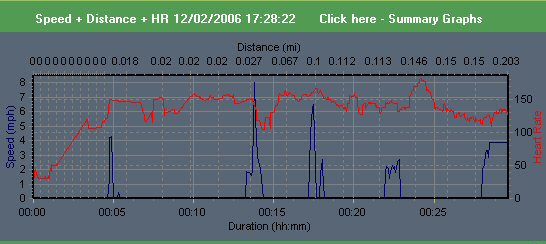Heart Rate Zone
Zone in on Your Fitness Goals and Take Yourself to the Next Level
By Paul "Batman" O'Brien
B.A., N.C.E.H.S., Dip. Acu., Cert Clin. IMed., Dip. Adv. OBB, Dip. CHM, Pn1, PN-SSR, PN-NCA, M.AFPA., M.C.Th.A.
Each Heart Rate Zone has a different effect on your body and briefly they are as follows;
- 50 – 60% of your max HR Zone
- 60 – 70% of your max HR Zone
- 70 – 80% of your max HR Zone
- 80 – 90 % of your max HR Zone
- 90 – 100% of your max HR Zone
In this article I’ll discuss each HR Zone in detail and comment on how to use them for maximum effect, based on your training goals.
If you'd like a more personal focus then you should consider online personal training with me. That way I can determine your optimal heart rate training levels and the best course of action to get you to your goals. Check it our here.
The Healthy Heart Rate Zone 50% – 60%
For a person aged 40 this would be between 90bpm -108bpm (50% -60% of 180). As long as you stay between those numbers you’ll be getting the benefits of this zone!
This zone is ideal for beginners, those new to exercise, or those with low functional ability. It’s easy and comfortable,comparable with a stroll for most people. In fact most walkers train in this Zone. It doesn’t burn many calories, and it’s not really going to develop your heart and lungs much. That said it’s proven to help decrease body fat, cholesterol levels, risk of degenerative diseases, and ease blood pressure. You’re also unlikely to do yourself an injury.
The calories you burn in this zone breakdown as follows –
- 10% from Carbohydrates
- 5% from Protein
- 85% from Fat!
The Fitness Heart Rate Zone - 60 – 70%
For a person aged 40 this would be between 108bpm – 126bpm (60% -70% of 180). As long as you stay between those numbers you’ll be doing well!
The breakdown is no different then the healthy zone, so why do this? Well, studies have shown that it results in increased fat mobilization while increasing your fat transportation. Basically, it gets fat out of your cells and into the muscles where they burn it off. As a result you teach your body to develop a faster metabolism, to burn off fat quicker! Thus you burn more calories than in the previous zone and 85% of that will be fat! Woohoo!
The calories you burn in this zone breakdown as follows –
- 10% from Carbohydrates
- 5% from Protein
- 85% from Fat!
My Own Heart Rate Zone Training Graph

The Aerobic Heart Rate Zone 70 – 80%
For a person aged 40 this would be between 126bpm – 144bpm (70% - 80% of 180). As long as you stay between those numbers you’ll be getting the benefits of this zone!
In this you will develop your functional fitness, (e.g. your ability to not get gassed when running after the bus you just missed). Your heart and lungs will greatly develop, becoming stronger and pumping more blood, with more oxygen around your body. This will increase the size and number of your blood vessels as they deal with this increased volume. Your resting heart rate will also go down as your stroke volume increases (the amount of blood pumped per heart beat), your resting heart rate is an excellent indication of your fitness levels, and the lower that goes the fitter you are! This means you burn even more calories then ever, but only 50% from fat!
The calories you burn in this zone breakdown as follows –
- 50% from Carbohydrates
- 1% from Protein
- 50% from Fat!
Anaerobic Heart Rate Zone 80 – 90 %
For a person aged 40 this would be between 144bpm – 162bpm (80% - 90% of 180). As long as you stay between those numbers you’ll be getting the benefits of this zone!
This zone is also known as the Threshold Zone. In this zone you will not have enough oxygen in your system to supply you (hence the name anaerobic – without sufficient oxygen). Thus the body uses an alternate system to supply itself with energy; this is called the glycemic cycle. Heavy weight training is primarily anaerobic. As a result of the lack of oxygen your body compensates by increasing the highest amount of oxygen you can consume – this is called you VO2 Max.
This leads to a higher lactate tolerance (a waste product produced by the energy cycle is called Lactic Acid. When this builds up the nerves cannot transmit signals to the muscles, leading to muscle failure. If you’ve ever felt like you couldn’t lift a weight one more time or take another step – this is what’s happening!). The end result is you will have greatly improved endurance. You also burn more calories because of the increased intensity but again, less fat!
The calories you burn in this zone breakdown as follows –
- 85% from Carbohydrates
- less than 1% from Protein
- 15% from Fat!
Red-line Heart Rate Zone 90% -100%
For a person aged 40 this would be between 162bpm – 180bpm (90% - 100% of 180). As long as you stay between those numbers you’ll be getting the benefits of this zone!
Good news is this burns the highest number of calories out of all the training zones. Bad news is it burns the least amount of fat. This is extremely intense work, and even highly trained athletes would find this hard to maintain for over 10 minutes. However, this is often used in Interval Training which I’ll discus in a later article. ONLY DO THIS IF CLEARED BY A PHYSICIAN DO SO!
The calories you burn in this zone breakdown as follows –
- 90% from Carbohydrates
- Less than 1% from Protein
- 10% from Fat!
So there you go – everything you need to know about Heart Rate Zone Training. In the
next article, here, I’ll discuss how to use this to your advantage in your training program










New! Comments
Have your say about what you just read! Leave me a comment in the box below.